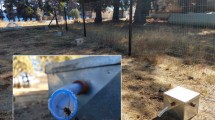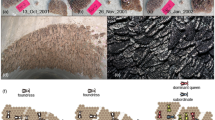Abstract
Collective behaviour, arising from local interactions1, allows groups to respond to changing conditions. Long-term studies have shown that the traits of individual mammals and birds are associated with their reproductive success2,3,4,5,6, but little is known about the evolutionary ecology of collective behaviour in natural populations. An ant colony operates without central control, regulating its activity through a network of local interactions7. This work shows that variation among harvester ant (Pogonomyrmex barbatus) colonies in collective response to changing conditions8 is related to variation in colony lifetime reproductive success in the production of offspring colonies. Desiccation costs are high for harvester ants foraging in the desert9,10. More successful colonies tend to forage less when conditions are dry, and show relatively stable foraging activity when conditions are more humid. Restraint from foraging does not compromise a colony’s long-term survival; colonies that fail to forage at all on many days survive as long, over the colony’s 20–30-year lifespan, as those that forage more regularly. Sensitivity to conditions in which to reduce foraging activity may be transmissible from parent to offspring colony. These results indicate that natural selection is shaping the collective behaviour that regulates foraging activity, and that the selection pressure, related to climate, may grow stronger if the current drought in their habitat persists.
This is a preview of subscription content, access via your institution
Access options
Subscribe to this journal
Receive 51 print issues and online access
$199.00 per year
only $3.90 per issue
Buy this article
- Purchase on Springer Link
- Instant access to full article PDF
Prices may be subject to local taxes which are calculated during checkout


Similar content being viewed by others
References
Pratt, S. C. & Sumpter, D. J. T. A tunable algorithm for collective decision-making. Proc. Natl Acad. Sci. USA 103, 15906–15910 (2006)
Clutton-Brock, T. & Sheldon, B. C. Individuals and populations: the role of long-term, individual-based studies of animals in ecology and evolutionary biology. Trends Ecol. Evol. 25, 562–573 (2010)
Garant, D. Kruuk, L. E. B., McCleery, R. H. & Sheldon, B. C. Evolution in a changing environment: a case study with great tit fledging mass. Am. Nat. 164, E115–E129 (2004)
Altmann, S. A. Diets of yearling female primates (Papio cynocephalus) predict lifetime fitness. Proc. Natl Acad. Sci. USA 88, 420–423 (1991)
Nussey, D. H., Wilson, A. J. & Brommer, J. E. The evolutionary ecology of individual phenotypic plasticity in wild populations. J. Evol. Biol. 20, 831–844 (2007)
Moyes, K. et al. Exploring individual quality in a wild population of red deer. J. Anim. Ecol. 78, 406–413 (2009)
Gordon, D. M. Ant Encounters: Interaction Networks and Colony Behavior. (Princeton Univ. Press, 2010)
Dingemanse, N. J., Kazem, A. J., Réale, D. & Wright, J. Behavioural reaction norms: animal personality meets individual plasticity. Trends Ecol. Evol. 25, 81–89 (2010)
Lighton, J. R. & Bartholomew, G. A. Standard energy metabolism of a desert harvester ant, Pogonomyrmex rugosus: effects of temperature, body mass, group size, and humidity. Proc. Natl Acad. Sci. USA 85, 4765–4769 (1988)
Lighton, J. R. B. & Feener, D. H., Jr Water-loss rate and cuticular permeability in foragers of the desert ant Pogonomyrmex rugosus. Physiol. Zool. 62, 1232–1256 (1989)
Gordon, D. M. & Kulig, A. W. Founding, foraging and fighting: colony size and the spatial distribution of harvester ant nests. Ecology 77, 2393–2409 (1996)
Gordon, D. M. Behavioral flexibility and the foraging ecology of seed-eating ants. Am. Nat. 138, 379–411 (1991)
Gordon, D. M. & Kulig, A. W. The effect of neighboring colonies on mortality in harvester ants. J. Anim. Ecol. 67, 141–148 (1998)
Ingram, K. K., Pilko, A., Heer, J. & Gordon, D. M. Colony life history and lifetime reproductive success of red harvester ant colonies. J. Anim. Ecol. 82, 540–550 (2013)
Gordon, D. M. How colony growth affects forager intrusion in neighboring harvester ant colonies. Behav. Ecol. Sociobiol. 31, 417–427 (1992)
Gordon, D. M. The development of an ant colony's foraging range. Anim. Behav. 49, 649–659 (1995)
Gordon, D. M., Holmes, S. & Nacu, S. The short-term regulation of foraging in harvester ants. Behav. Ecol. 19, 217–222 (2008)
Gordon, D. M., Guetz, A., Greene, M. J. & Holmes, S. Colony variation in the collective regulation of foraging by harvester ants. Behav. Ecol. 22, 429–435 (2011)
Prabhakar, B., Dektar, K. N. & Gordon, D. M. The regulation of ant colony foraging activity without spatial information. PLoS Comp. Biol. 8, e1002670 (2012)
Beverly, B. D., McLendon, H., Nacu, S., Holmes, S. & Gordon, D. M. How site fidelity leads to individual differences in the foraging activity of harvester ants. Behav. Ecol. 20, 633–638 (2009)
Adler, F. R. & Gordon, D. M. Optimization, conflict, and non-overlapping foraging ranges in ants. Am. Nat. 162, 529–543 (2003)
Davidson, D. W. Some consequences of diffuse competition in a desert ant community. Am. Nat. 116, 92–105 (1980)
Gordon, D. M. The spatial scale of seed collection by harvester ants. Oecologia 95, 479–487 (1993)
Cassill, D. L. & Tschinkel, W. R. Allocation of liquid food to larvae via trophallaxis in colonies of the fire ant, Solenopsis invicta. Anim. Behav. 50, 801–813 (1995)
Gordon, D. M. & Holldobler, B. Worker longevity in harvester ants. Psyche (Stuttg.) 94, 341–346 (1987)
Ingram, K. K., Kleeman, L. & Peteru, S. Differential regulation of the foraging gene associated with task behaviors in harvester ants. BMC Ecol. 11, 19 (2011)
Johnson, R. A. & Gibbs, A. G. Effect of mating stage on water balance, cuticular hydrocarbons and metabolism in the desert harvester ant, Pogonomyrmex barbatus. J. Insect Physiol. 50, 943–953 (2004)
Acknowledgements
Thanks to the many people who helped with field work: in 1986 and 1987, K. Roth; in 2011, X. Ampuero, K. Dektar, M. Greene, J. Hickman, A. Merrell and N. Pinter-Wollman; in 2012, J. Queirolo, J. Rasiel, C. Wayne; in both 2011 and 2012, S. Crow, L. Howard and E. Pless. Many thanks to M. Coram for statistical advice and help. I am grateful to D. Kennedy and J. Ober for helpful discussions and to M. Feldman and W. Flesch for comments on the manuscript. The work was funded by the Stanford Office of the Dean of Research, Stanford Emergence of Cooperation Project and the National Science Foundation grant IOS-0718631.
Author information
Authors and Affiliations
Corresponding author
Ethics declarations
Competing interests
The author declares no competing financial interests.
Supplementary information
Supplementary Information
This file contains Supplementary Tables 1-2. (PDF 97 kb)
PowerPoint slides
Rights and permissions
About this article
Cite this article
Gordon, D. The rewards of restraint in the collective regulation of foraging by harvester ant colonies. Nature 498, 91–93 (2013). https://doi.org/10.1038/nature12137
Received:
Accepted:
Published:
Issue Date:
DOI: https://doi.org/10.1038/nature12137
This article is cited by
-
Behavioral and morphological traits influencing variation in task performance of Camponotus vagus ants
Insectes Sociaux (2023)
-
Bilevel optimization based on foraging by different ant species for real-time transportation planning
Evolutionary Intelligence (2023)
-
The red harvester ant
Nature Methods (2022)
-
The ant colony as a test for scientific theories of consciousness
Synthese (2021)
-
Task specialization and structure attrition: neotropical social wasps may disperse the cost of mandible demanding labors throughout their lives
Zoomorphology (2021)
Comments
By submitting a comment you agree to abide by our Terms and Community Guidelines. If you find something abusive or that does not comply with our terms or guidelines please flag it as inappropriate.



